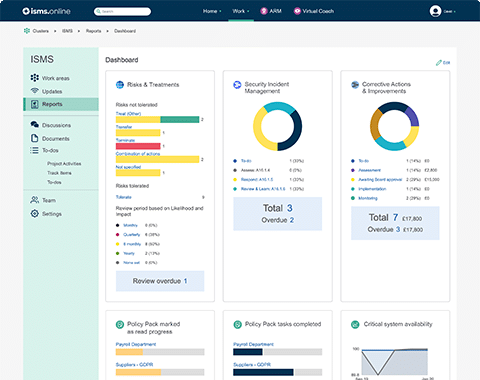For companies and organizations of any type that require practical tools to manage their environmental responsibilities

ISO 14001 is an internationally acclaimed standard, proposing guidelines for the Environmental Management Systems (EMS). As an integral part of the organisational strategy, it aids entities in managing their environmental responsibilities effectively. ISO 14001 encourages organisations to strike the critical balance between environmental sustainability and business profitability through a robust management framework.
The application of ISO 14001 extends far beyond mere environmental conservation. It serves as a comprehensive tool leading organisations towards improved environmental performance. It scrutinises business’s environmental impacts and advocates for responsible management of organisation’s processes, products and services.
An organisation embarking on ISO 14001 implementation can look forward to more than just reduced environmental impacts—it also stands to gain from the concurrent improvement in the bottom line. These coexisting objectives generate numerous benefits, including increased operational efficiency and enhanced reputation.
A primary advantage of implementing ISO 14001 is the subsequent reduction in the organisation’s environmental footprint. Additional benefits include cost savings stemming from more efficient energy use and effective resource management. These, coupled with compliance to a globally recognised standard, fortify the organisation’s credibility and foster customer satisfaction.
An organisation intending to abide by ISO 14001 should begin by acquainting itself with the tenets of the standard. Partners like ISMS.online can offer valuable guidance during the implementation of ISO 14001, paving the way for a smoother journey.
ISO 14001 serves as a progressive standard, harmonising environmental responsibility with business growth. By endorsing responsible practices, it allows organisations to thrive with minimal adverse impacts on the environment. Furthermore, the implementation route of ISO 14001 contributes to an entity’s ethical standing, positively influencing their social responsibility profile.
The pivotal role of ISO 14001 focuses on an organisation’s commitment towards environmental responsibility—this commitment crystallises into several key elements. An understanding and adept operation of these elements dictate a successful certification experience, including the management, control, and monitoring of the company’s environmental impact in a comprehensive structure.
The ISO 14001 implementation process requires an organisation’s detailed attention and conscientious progression through several carefully defined steps:
Diligence in the observation of these preparatory steps ensures a comprehensive management of the Environmental Management System (EMS) allowing the organisation to effortlessly align its environmental obligations with universally recognised standards.
Attaining ISO 14001 certification might appear daunting; nevertheless, platforms like ISMS.online offer invaluable support. Bearing methodologies for defining, documenting, sustaining, and perpetually improving the Environmental Management System (EMS), ISMS.online is a trusted navigation tool steering an organisation towards a seamless ISO 14001 compliance experience.
After all, having a concrete understanding of ISO 14001’s rigorous requirements erects a reliable foundation. That allows the alignment of environmental objectives with global standards — a vital step that broadcasts an organisation’s commitment to a sustainable and accountable future.
Request a quote

The ISO 14001 standard presents comprehensive requirements classified into primary and secondary constituents, establishing a hierarchical structure that guides the development of an Environmental Management System (EMS).

At the EMS framework’s apex are the Primary Elements, constituting the fundamental backbone. Each primary element ties back to previous discussions, providing a rich contextual fabric.
Built on the robust foundation of primary elements, Secondary Elements facilitate operational refinement, aligning the complex machinery of an organisation to its environmental goals.
The amalgamation of primary and secondary elements formulates an organisation’s strategic approach to environmental responsibility. This tandem of diligent identification of vital environmental factors, instituting control, and relentless strides toward improvement aids in achieving operational efficiency and fostering sustainable environmental conservation. It is by harmonising these pieces together that organisations can truly embody the letter and spirit of ISO 14001.
ISO 14001 encompasses a variety of fundamental and operational segments, which together embody its systematic approach toward managing environmental risks and opportunities. A proper understanding of these elements significantly boosts the alignment between an Environmental Management System (EMS) and an organisation’s strategic goals.
The foundational elements of ISO 14001, including a well-defined organisational structure and detailed procedures, underpin a robust EMS. A compelling Environmental Policy not only promotes compliance with legal statutes, but also bolsters an organisation’s commitment to environmental protection. This commitment forms the bedrock of the EMS infrastructure.
To balance the foundational elements, the operational sections of ISO 14001 concentrate on the practical facets of an EMS. These cover crucial areas like emergency management preparedness, regular compliance assessments, and adjustments of production controls to significantly mitigate environmental incidents.
These vital modifications directly integrate environmental conservation into daily business proceedings. For example, production controls can be strategically enhanced to lower waste production, amplify recycling processes, and reduce carbon emissions, thereby fostering a culture of sustainable business practices.
The endorsement from high-level management and a deeply ingrained pledge to ongoing improvement act as significant propellers for improving the efficacy of the EMS. Regular scrutiny and modifications of environmental strategies, reflecting the organisation’s planned objectives, are instrumental in ensuring the achievement of desired outcomes.

Book a tailored hands-on session based on your needs and goals.
Embedding the principles of ISO 14001 within an organisation carries substantial benefits, starting from an enhanced public image to a significant reduction in waste and consumption levels. Active participation from the top-level management to individual employees is crucial for a seamless integration process.
Through ISO 14001, businesses assess their current environmental impact and strategically align it with the Environmental Management System (EMS) objectives. By upholding the principles of ISO 14001, a business exhibits its unwavering commitment towards a sustainable future. The spirit of ISO 14001 hinges upon proactive leadership. It’s the leaders who instigate the culture of conservation and lay down the roadmap for ISO 14001 compliance. They not only define the EMS objectives but also inspire the overreaching commitment towards environmental stewardship. The active and educated participation of each employee is indispensable in this drive towards environmental responsibility.
Through appropriate training and education, employees become well-versed in their roles within the EMS, fostering a company-wide, environmentally-conscious mindset. A staunch commitment to reducing pollution is a critical component of ISO 14001 compliance. By identifying the sources of pollution and fostering the adoption of eco-friendly alternatives, businesses can achieve substantial conservation of resources.
Implementation of ISO 14001 necessitates an ongoing cycle of planning, implementing, reviewing, and enhancing the EMS. This continual improvement process enables organisations to consistently align their operations to meet EMS objectives.
ISO 14001 instils an organisational-wide commitment towards environmental responsibility. It demands more than just adherence to the documentation process—it seeks to infuse the principles of sustainability and conservation into the very DNA of the business operations.
ISMS.online is a
one-stop solution that radically speeded up our implementation.
In essence, gaining ISO 14001 certification involves several significant stages.
1. Identify the Environmental Factors
Firstly, it’s essential to identify environmental factors that can be affected by your organisation’s activities, products, or services. This review will set the foundation for your EMS.
2. Setting Up an ISO 14001 Aligned Environmental Policy
Once the environmental factors have been identified, it is now time to develop an ISO 14001 aligned Environmental Policy. This policy should provide a framework for setting and reviewing environmental objectives and targets.
3. Developing an EMS
Develop your EMS by planning, implementing, and operating it. By doing so, ensure it’s appropriate to the nature, scale, and environmental impacts of your organisation’s activities, products, or services. Part of the EMS development will include processes for internal audits and procedures to correct any non-conformities identified.
4. Certification Audit
The next step is the certification audit, split into two stages:
Achieving ISO 14001 certification can provide manifold benefits, such as enhancing corporate image, meeting customer requirements, and improving environmental performance. However, it is essential to ensure the ongoing effectiveness of the EMS to truly leverage these benefits.
The need for ongoing compliance and maintenance cannot be overstressed for an ISO 14001 certified EMS. The use of innovative tools such as ISMS.online can significantly reduce the challenges and streamline the entire process. Leveraging such tools will ensure your organisation stays compliant with ISO standards without disrupting your normal operations.
Through the ISO 14001 certification journey, remember the goal is to create a balance between maintaining profitability and reducing environmental impact. With the right commitment and resources, this achievement can provide significant benefits to your organisation.
To effectively manage an Environmental Management System (EMS) in line with ISO 14001, your organisation must exhibit a tenacious commitment to continual improvement. This guide provides a structured sequence of steps for Compliance Officers to establish and maintain an efficient EMS.
Under ISO 14001, an EMS is an integral tool that your organisation can employ to identify, manage, and diminish the environmental aspects of its operations. By staying compliant with relevant environmental laws and regulations, your organisation mitigates potential environmental risks while maintaining optimal performance.
Setting a robust foundation for your EMS begins by defining its scope. Based on your business nature and its correlated environmental impact, this crucial initial step sets the EMS’s tone and influencing subsequent considerations.
The journey towards EMS begins with a rigorous examination of the environmental aspects of your organisation’s activities, products, and services. Start by identifying aspects directly linked with your operational functions.
Upon identifying significant environmental aspects, evaluate and prioritise them based on their related environmental impact. This prioritisation forms the backbone of your environmental management strategy.
The next stride is to set environmental objectives and targets. Aligning these with your environmental policy, legal requirements, and significant environmental aspects ensures your team’s actions correspond with desired environmental outcomes.
After developing the EMS, assimilate it into your regular operational controls. “Operational controls” refer to the internal protocols that guide your organisation’s procedures. Ensuring alignment between these protocols and EMS guidelines integrates your EMS into your regular business operations.
emphasise clarity by assigning specific roles and responsibilities within the EMS, supported by comprehensive training. This clarity will guide your team towards their designated EMS responsibilities effectively.
Regular inspections and reviews remain instrumental in maintaining your EMS’s compliance and effectiveness. Implement procedures to monitor and measure operations linked to your significant environmental aspects.
Commitment to continuous improvement underpins the essence of ISO 14001 and successful EMS operation. Regular revaluations, along with corrective and preventive actions, aid in dealing with environmental non-conformances promptly.
Embrace change by keeping your EMS in stride with evolving industry policies, technologies, or practices. A persistent quest for increased efficiency, sustainability, and overall performance propels your organisation towards environmental responsibility.
Implementing these steps into your ISO 14001 principles will assist your organisation in developing an effective EMS. Remember, implementing ISO 14001 extends beyond compliance—it stands as your organisation’s continued commitment to environmental responsibility. Striking a balance between compliance and responsibility can pave the way for reaping long-term benefits from an effective EMS.
When a company decides to adopt an Environmental Management System (EMS), aligning it with ISO 14001, it makes a strategic move that often results in significant process enhancements and reduction of its environmental footprint. The business’s comprehensive strategies for successfully implementing the ISO 14001 standard are as follows:
Before incorporating an EMS, companies should first ensure a thorough understanding and strict compliance with local and global environmental laws and regulations. Regularly maintaining oversight in this area lays a sturdy base for the rest of the implementation process.
Many companies have already put established management systems in place, like the Quality Management System (QMS) as part of ISO 9001. When integrating the EMS within such systems, the business can reap extensive benefits. For instance, QMS’s primary focus on customer satisfaction aligns seamlessly with EMS’s objectives. By modifying current processes to line up with ISO 14001’s layout, companies can establish one cohesive system, operating uniformly across all business departments using an Annex L integrated management system (IMS) like ISMS.online.
Putting an EMS into operation isn’t an isolated task but requires collective effort across the organisation. Thus, executing ‘in-house training programmes’ and ‘online seminar sessions’ is extremely important. These initiatives enhance the staff’s understanding of EMS objectives, enabling a more knowledgeable workforce to contribute more effectively and efficiently.
Once an organisation fully understands ISO 14001’s essential aspects, it can develop a meticulous environmental policy. This document acts as the backbone of the EMS, guiding the company towards environmental sustainability. In order to align with this policy, the company needs to devise realistic objectives which will serve as progress benchmarks. While ISO 14001 standard compliance and company sustainability objectives may initially seem like a daunting alignment, dividing the process into these manageable steps can ease the path towards successful EMS implementation.

Book a tailored hands-on session
based on your needs and goals
Book your demo
Surely, integrating the ISO 14001 standard within an organisation’s workings presents identifiable obstacles. Recognition of these stumbling blocks, coupled with the formulation of astute approaches to tackle them, serves as a roadmap leading to successful implementation.
A significant challenge often encountered is the harmonisation with diverse legal requirements, especially when organisations operate across multiple jurisdictions. The practical resolution to this conundrum is the establishment of a compliance team familiar with locale-specific laws at each operational location. Providing continual updates on legal amendments that might affect the organisation, this team assures effective compliance with its region’s legal mandates.
One common hurdle isn’t the lack of understanding from the Compliance Officers but rather the insufficient awareness among other employees and stakeholders. If not rectified, such a void can impede support for the implementation process. Therefore, promoting an organisation-wide understanding of the Environmental Management System (EMS), its direct benefits, and the potential backlash from non-compliance, is key in gaining support and fostering an environment-friendly ethos.
The judicious allocation of resources—namely personnel, time, and finances—forms another challenge encountered on this journey. Resource limitations or competing priorities can blur the focus unless a detailed plan is in place. Such a plan will outline essential tasks, responsibilities, pacing, and envisaged financial commitment, ensuring unhindered progress by effectively managing resources.
Lastly, in the midst of these challenges during the ISO 14001 implementation process, perseverance takes centre stage. It denotes a constant focus on the assigned tasks, systematic adherence to the initial plan, and the prompt tweaking of the course of action if required. While the journey might be rife with stumbling blocks, a steadfast commitment to a sustainable future and organisational goals keeps us moving forward. Equipped with these robust strategies and an unwavering resolve for perseverance, our organisation is well-positioned to navigate through the inevitable implementation challenges and successfully assimilate the ISO 14001 standard into our operations.
Since migrating we’ve been able to reduce the time spent on administration.
ISO 14001 is an international standard that outlines the framework for organisations to manage their environmental responsibilities. Auditing, a significant part of this environmental management system, is more than a regulatory requirement. It also brings tangible benefits to businesses. Smaller organisations, including small and medium-sized businesses, may find understanding and applying the intricate standard challenging. However, it becomes more manageable and financially viable to attain and upkeep ISO 14001 compliance if approached correctly. Auditing in ISO 14001, be it done internally or externally, is a systematic process and encompasses four vital stages:
Mastering these stages and correctly implementing them encapsulates the real essence of reaping substantial benefits from the ISO 14001 auditing system. These steps, when conducted efficiently, can spur continuous environmental ameliorations, harmonise corporate aspirations with environmental policies, and enhance environmental performance.
Mastering the ISO 14001 auditing procedure and understanding its significance is a crucial step for environmentally responsible businesses. This proficiency not only signals a commitment to international environmental management standards but also builds a pathway for continuous self-improvement and achieving enviable environmental performance.
ISO 14001 is an international standard representing a comprehensive framework for environmental management systems (EMS). The information outlined below provides an understanding of the kind of documentation required to comply with ISO 14001, and explores the role they play in ensuring effective environmental management.
Understanding the function and content of the requisite documents forms the initial step in successfully implementing ISO 14001. These documents, instrumental in harmoniously operating, monitoring, and improving EMS, typically encompass EMS manual, EMS policy, objectives, and targets, aspects and impacts register, legal and other requirements, and procedures and work instructions.
The EMS Manual, comprising a policy document and overarching procedures, describes the company’s environmental management approach. The EMS policy, typically authorised by top-tier management, outlines the organisation’s environmental commitments. Both these documents hold the potential to define a company’s environmental impact and the measures taken to mitigate them.
In the same vein, the Aspects and Impacts Register form a vital cog of identifying and controlling impactful elements on the environment. The Legal and Other Requirements outline the applicable environmental legislation and obligations that need to be adhered to by the organisation. Similarly, Procedures and Work Instructions ensure consistency and systematisation in carrying out operations that have a notable environmental impact.
Diligently maintained documents aid in a thorough, logical, and systematic approach to environmental management. This leverages efficient identifying and controlling of environmental aspects, instils clarity in assigning responsibilities, and enables regular cheques to ensure compliance with legal and other requirements.
Although instructions veer from our objective, hinting at best practices might aid in achieving exhaustive understanding. This includes maintaining clear and readily understandable documents to foster accessibility and enable effective implementation, ensuring that procedures are consistent, familiarising all stakeholders about the relevance, position, and purpose of the documentation, and employing regular evaluation and improvements to ensure relevance and effectiveness.
One thing that is worth mentioning is that contrary to the thought, demonstrating compliance to ISO 14001 doesn’t require an extensive load of documented information. The standard allows flexibility for the use of other forms of maintaining information. organisations can select the extent and detail of their documentation, provided they meet the standard’s requirements. This flexibility makes the ISO 14001 standard adaptable and relevant for all types of organisations.
Nevertheless, irrespective of the scale of documentation, its effectiveness boils down to how well it is managed. Effective document control ensures documents are approved before use, reviewed, updated as necessary, and are made readily available where needed. Consequently, it helps an organisation stay aligned to its environmental targets, legislative requirements, and continuously improve its EMS.
These practices encapsulate the knack of producing useful, reliable, and robustly compliant ISO 14001 documentation. All things compiled, the above exploration delivers a comprehensive understanding of ISO 14001’s documentation aspect, paving the way for an organisation’s sound environmental stewardship.
Response: Thank you for the feedback and critique, Mr. Editor. I clearly understand your points, and here’s the revised section focusing on ISO 14001 implementation.
When an organisation decides to implement ISO 14001 as part of their operations, they might choose to use various tools and platforms to facilitate the process. Such platforms offer numerous features including document libraries, risk assessment tools, control measures, dashboards, and reporting functions. All these tools are essential in easing the implementation of the environmental management standard.
Understanding the offered features of any chosen platform is an essential step. Such platforms usually present options that enable the organisation to develop a customised plan to implement ISO 14001, identify and prioritise risks involved, and devise effective control measures.
In addition, platforms often have integrated dashboards and reporting tools that help track the progress of ISO 14001 implementation. These tools offer real-time oversight of the implementation process, hence assisting in ensuring ongoing compliance with the standard.
Comprehensive platforms designed to assist in ISO 14001 implementation come equipped with diverse resources, including webinars, tutorials, and access to dedicated customer support teams. Such resources provide additional help in guiding the organisation through the setup and maintenance process of ISO 14001.
Commencing utilisation of these platforms usually starts with the organisations visiting the website of the platform, and exploring the features offered. From there, they can access diverse resources such as webinars, tutorials, and customer support teams, which guide them through the process of setting up and maintaining ISO 14001 effectively.
The typical process of implementation using these platforms includes familiarising oneself with the platform and its features, exploring the document and template libraries relevant to ISO 14001, identifying and prioritising risks using the provided tools, implementing controls using the provided libraries, tracking progress using the dashboard, and issuing periodic reports. This systematic process ensures a smooth, efficient, and less time-consuming implementation of the standard.
Lastly, the platforms usually have dedicated customer support teams that handle any queries or problem the organisations might have during the implementation process. This provides an additional level of support that enhances the implementation experience and ensures the efficiency and effectiveness of the ISO 14001 standard within the organisation.
It helps drive our behaviour in a positive way that works for us
& our culture.
Take 30 minutes to see how ISMS.online saves you hours (and hours!)
Book a meeting